Dental implants are screw-shaped prosthetic roots, typically composed of titanium, that are surgically implanted into the jawbone to supplant natural teeth. It assumes the shape and size of a real tooth after having a crown made of zirconium or porcelain placed on top. Because they preserve the jawbone and do not harm neighboring teeth, implants are among the most effective treatment options available today. (1)
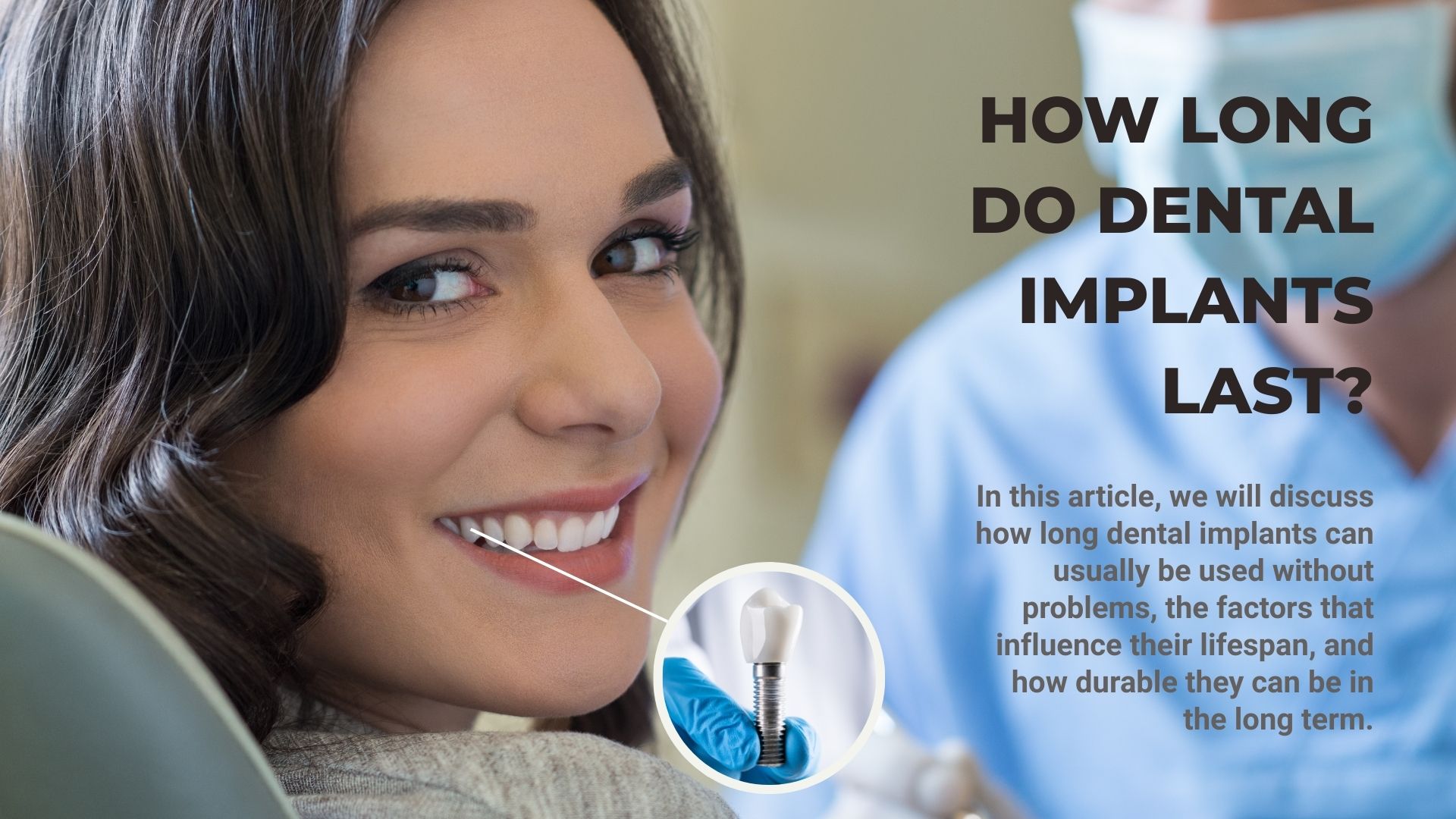
Why, therefore, is the expected lifetime of dental implants a matter of paramount importance? Reason being, the medical and financial costs associated with getting an implant are substantial. Everyone hopes to have sturdy dental implants that they can use for life if possible. In this article, we will discuss how long dental implants can usually be used without problems, the factors that influence their lifespan, and how durable they can be in the long term. We will also address frequently asked questions such as whether implants can really last a lifetime, their condition after 20 years, and how long their superstructures (crowns) can be used.
Average Lifespan of Dental Implants

The long-term success rate of implants is extremely high, according to scientific research. In 10-year clinical follow-up studies, the survival rate of implants is between 82% and 94%. (1) The reported success rates for crown restorations on single implants are approximately 95% and for bridges with multiple implants, over 90% after 10 years. Of course, each case is different, but in general, most dental implants in regularly cared for patients work well for more than 10 years.
Even longer-term data are encouraging. The 15-year success rate of dental implants has been reported to be over 90% in the lower jaw. At the end of 15 years, 91 per cent of the implants in the lower jaw and 81 per cent in the upper jaw were reported to be functioning properly. According to these findings, a properly placed implant has the potential to last for many years.
It is during the first few weeks of treatment that the risk of implant failure or loss is highest. The first few months after implant placement, especially the first 6-12 weeks, is a critical healing period. This is when the implant fuses with the surrounding bone (osseointegration). Therefore, an implant that survives the first years without problems usually lasts a very long time. (1)
Factors Affecting Implant Life
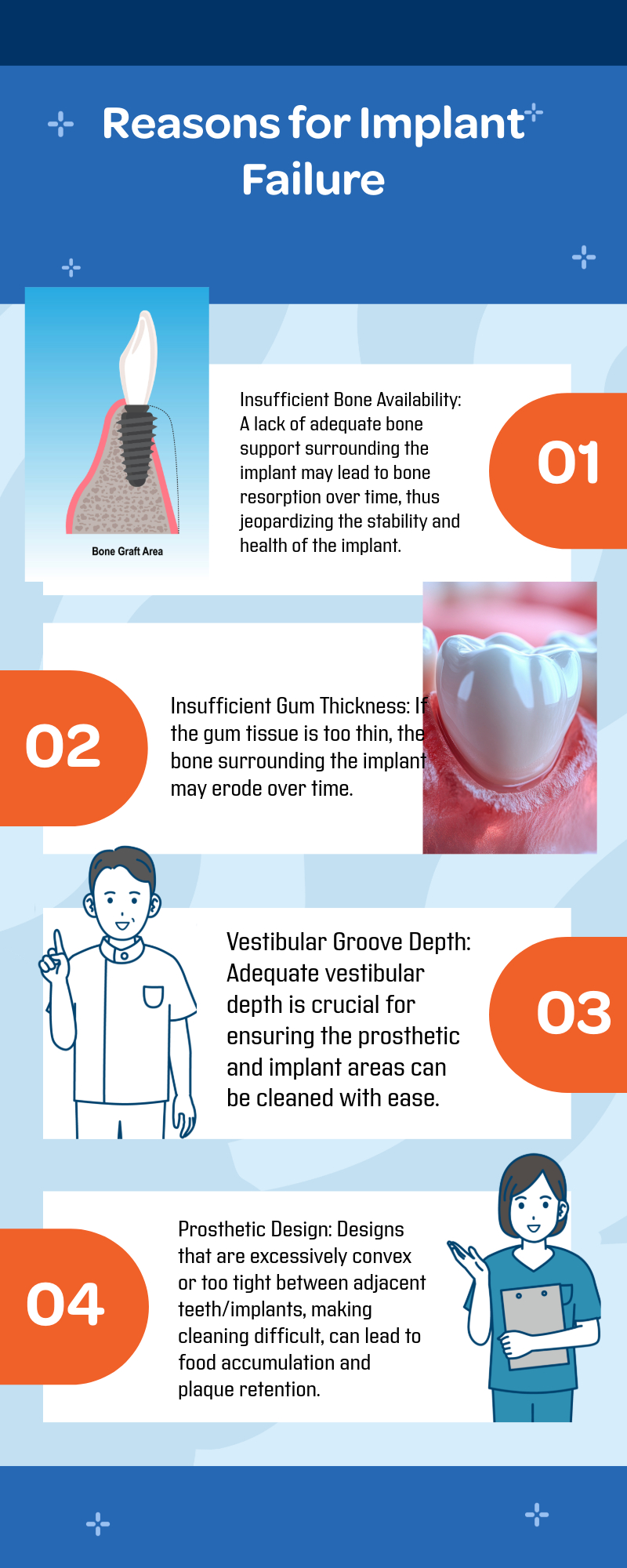
There are many biological, mechanical and patient-related factors that determine how long a dental implant will remain healthy. Aside from the material's quality, other factors that affect the implant's longevity include surgical technique, prosthetic design, and the patient's care habits. Some important factors that can impact the success and longevity of dental implants are as follows:
- Insufficient bone: Having enough healthy bone around the implant is one of the basic conditions for long-term success. There should be at least 1 mm thick solid bone tissue around an implant in all directions. A minimum of 1.5 mm of bone space should be maintained between the implant and any adjacent natural teeth, and a minimum of 3 mm should be maintained between any two implants. Due to inadequate bone support, bone resorption may develop over time if the implant is placed in a narrow bone or if there isn't enough bone surrounding it. This raises the possibility of infection and compromises the implant's stability. Bone grafts, which involve applying bone powder, can increase bone volume before an implant is placed. These methods have successfully solved many cases of "insufficient jaw bone" in recent years.
- The quantity and thickness of adherent gum: The soft tissue quality surrounding the implant is just as crucial as the bone. Gingiva that is sufficiently thick around the implant aids in maintaining healthy bone. The implant area should have enough gum tissue that is at least approximately 3 millimeters thick. If the gum is too thin, the bone around the implant may dissolve over time.
- Vestibular groove depth:
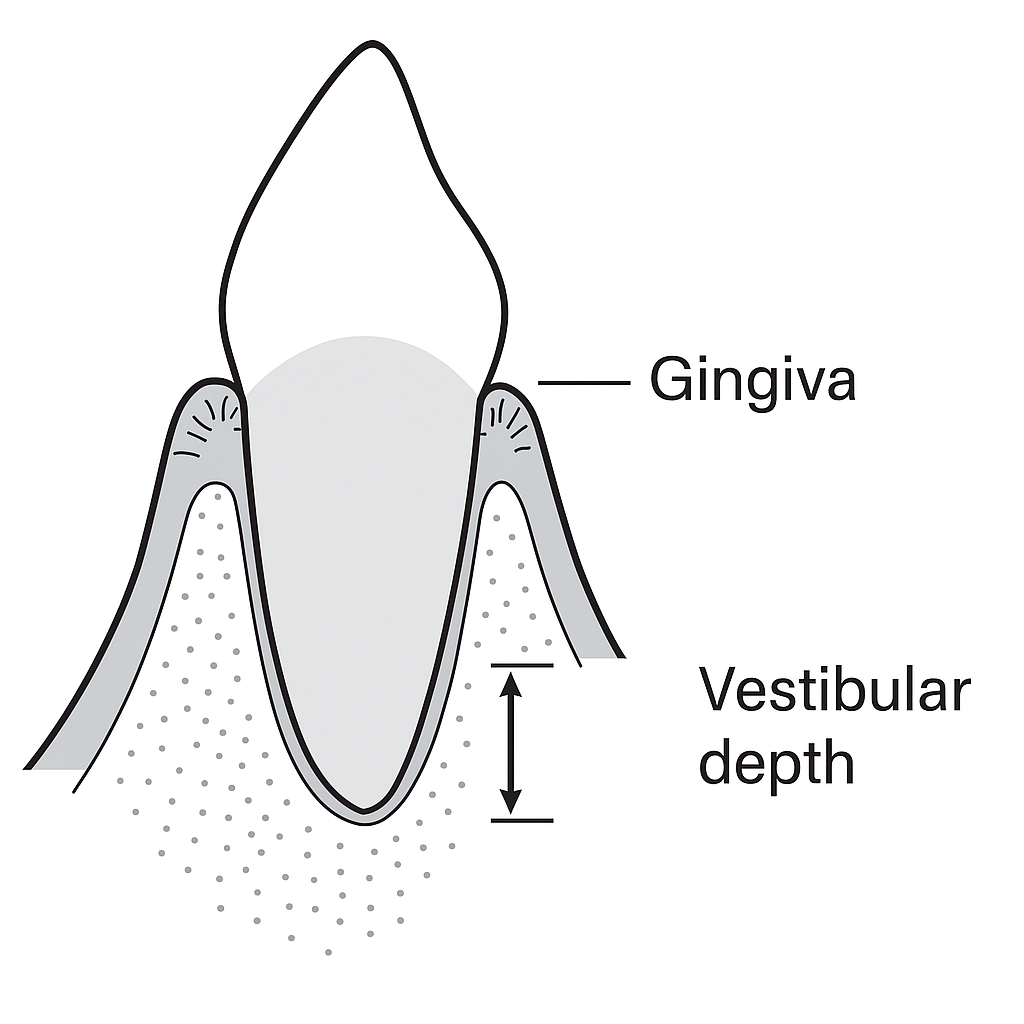
As a result of the resorption of the jawbone over the years after tooth extraction, the groove in the lip or cheek, called the vestibule, may become shallow. If this groove becomes too shallow, the cheek muscles can push food residues onto the crown of the implant during eating. This makes cleaning around the implant difficult and can cause constant irritation and inflammation/loss. It is important to have a vestibular groove of sufficient depth so that the prosthesis and the implant can be cleaned easily.
- Surgical technique and healing: The technique used during surgical placement of the implant plays a critical role in long-term success.It is crucial to prevent excessive thermal elevation of bone during surgery (utilizing a low-speed surgical drill and cooling mechanisms) and to minimize unnecessary bone trauma. The preparation of the implant socket should be controlled and gentle. After the implant has been inserted, a certain healing period is required. During this period, forces on the implant should be limited (usually no pressure is applied to the implant for several months or temporary prostheses are used with caution).
- Implant material and surface properties: The vast majority of implants are made of titanium and their surfaces are roughened to provide better integration with bone. This roughened surface facilitates the attachment of bone cells to the implant surface and accelerates osseointegration. However, the rough part of the implant should not be exposed at or above the gingival level and must remain in the bone. If the rough surface of the implant remains on the gum or is exposed over time, bacteria and plaque can easily adhere to these rough surfaces. As a result, gingivitis and bone resorption can develop around the implant. For this reason, ideally the implant neck (the part at the gum level) should be shiny and polished, and the rough surface should only be in the area within the bone.
- Prosthesis design: The design of the implant's superstructure, which can be a crown, bridge, or prosthesis, is crucial. The shape of the prosthesis should be such that the patient can comfortably perform daily oral care. Especially in the border area between the tooth and gum, the prosthesis should not be excessive and should harmonize properly with the gum. Excessively curved outwards (convex) designs or too tight between the adjacent tooth/implant to be cleaned lead to food accumulation and plaque retention. The result may be localized bone loss and persistent inflammation. Also, crowns placed over implants should have spaces between them to accommodate the interface brush and dental floss. Otherwise, the patient cannot clean that area and problems will occur in the long term.
- Cement residues: Crown or bridge prostheses are either screwed onto the implant or cemented with cement (special adhesive cement). If cement is used, it is essential to thoroughly clean the cement residues after the bonding process. If the dentist does not remove these residues completely, even a small piece of cement remaining under the gum can cause chronic irritation. Over time, peri-implantitis (peri-implantitis) develops in this area and bone resorption begins. Therefore, when using the cementation technique, special care must be taken not to leave any residue.
- Abnormal bite forces (occlusal problems): Implants are designed to withstand chewing forces, but excessive or incorrectly directed forces can cause problems in the long term. Especially in people who have a habit of clenching/grinding (bruxism), the implant and the prosthesis on it are subjected to much more stress than normal. Similarly, incompatible contacts of the implanted tooth with the teeth in the opposite jaw during chewing (e.g. premature contact in lateral movements, i.e. occlusal interference) can damage the implant surroundings.
- Poor oral hygiene: The patient's oral care habits are one of the most important factors in the longevity of the implant. The gum around the dental implant needs to be cleaned regularly, just like the natural gum. The patient should brush around the dental implant at least twice a day and remove plaque around the implant with dental floss or an interface brush. If oral hygiene is neglected, bacterial plaque can accumulate and lead to gingivitis (mucositis) and, if left untreated, to deeper bone loss (peri-implantitis).
- Systemic health conditions: The general health status of the patient may affect the healing success and long-term stability of the implant. Factors such as uncontrolled diabetes (high blood sugar), immunosuppressive drugs used for autoimmune diseases, cancer patients undergoing chemotherapy/radiotherapy, smoking, conditions leading to dry mouth and hormonal changes (e.g. pregnancy) may adversely affect the health of the peri-implant tissues. It is known that the risk of implant failure and bone loss is particularly increased in patients who smoke.
If blood sugar is not under control in diabetic patients, wound healing is delayed and the risk of infection increases. Patients with such systemic risk factors require closer follow-up and careful care after implantation. Despite this, implantation can still be a viable option for many patients with these conditions as long as the appropriate precautions are taken by the doctor.
- Implants do not feel pain or decay: When there is a problem with our natural teeth, we usually get symptoms such as pain, aching, hot-cold sensitivity. Dental implants, however, do not contain nerves, so they do not cause pain or hot and cold sensitivity. Titanium implants also do not decay. It must not be overlooked that X-rays and a specialist's examination are the only ways to identify problems that cannot be specifically identified.
Can Teeth Implants Last a Lifetime?
If all goes according to plan, dental implants are a treatment that could last a lifetime. Thus, in theory, a single implant can serve a person for the rest of their lives. However, whether this is realised in practice depends on many factors detailed above. Nevertheless, there are cases in the scientific literature where implants remain in the mouth for 20-30 years and longer. There are case reports and long-term studies of implants that have been in the mouth for 20 years or even 30 years or more and are still functioning well. That implants that work well for the first several years are highly unlikely to cause issues in the subsequent years is the most significant finding supporting the idea that implants can last a lifetime.
In most cases, the expected lifespan of an implant is significantly greater if it performs adequately during the initial five years. While no treatment can provide a 100% lifetime guarantee, implants can offer longevity comparable to the human lifespan.
What Happens to Dental Implants After 20 Years?
Ideally, after 20 years, your implant may still be as good as the first day. After getting implants in their twenties or thirties, many patients have no issues continuing to use them well into middle age. On average, 8-9 out of every 10 implants continue to function after 20 years.
After 20 years in the mouth, the area surrounding an implant may have experienced gum recession or a decrease in bone level. Depending on the patient's gum biotype and level of oral hygiene, this is a normal and expected part of the aging process for both natural teeth and implants. It has been reported in the literature that the marginal bone height around the implant, especially after the first year of adaptation, can be lost very little each year (e.g. ~0.1 mm per year). In studies with 10-year follow-up, bone loss around the implant is reported to be around 1 mm in total. If the bone loss around the implant is not excessive (e.g. no more than 2-3 mm in 20 years) and gum health is under control, the implant usually remains stable.
How Often Should I Replace Teeth Implants?
An implant treatment basically consists of two parts. The first part is the titanium implant itself (the screw-shaped part), which is placed in the jawbone. The second part is the prosthetic structure (superstructure such as a single tooth crown, a bridge with multiple teeth or a full palatal prosthesis). The two components' expected lifetimes and eventual replacement needs might be different:
When compared to joint prostheses, such as knee or hip prostheses, dental implants have a far longer lifespan and do not wear out as quickly. If there are no problems with an implant, it is intended to remain in the mouth for life.
Like veneers on real teeth, implant-supported porcelain crowns and bridges can wear down, break, or require replacement at some point. The typical lifespan of a porcelain crown is estimated to be between ten and fifteen years. Although there are crowns that last much longer without issues, aesthetic or functional concerns may necessitate replacement after 10 years.
How Long Do Titanium Dental Implants Last?
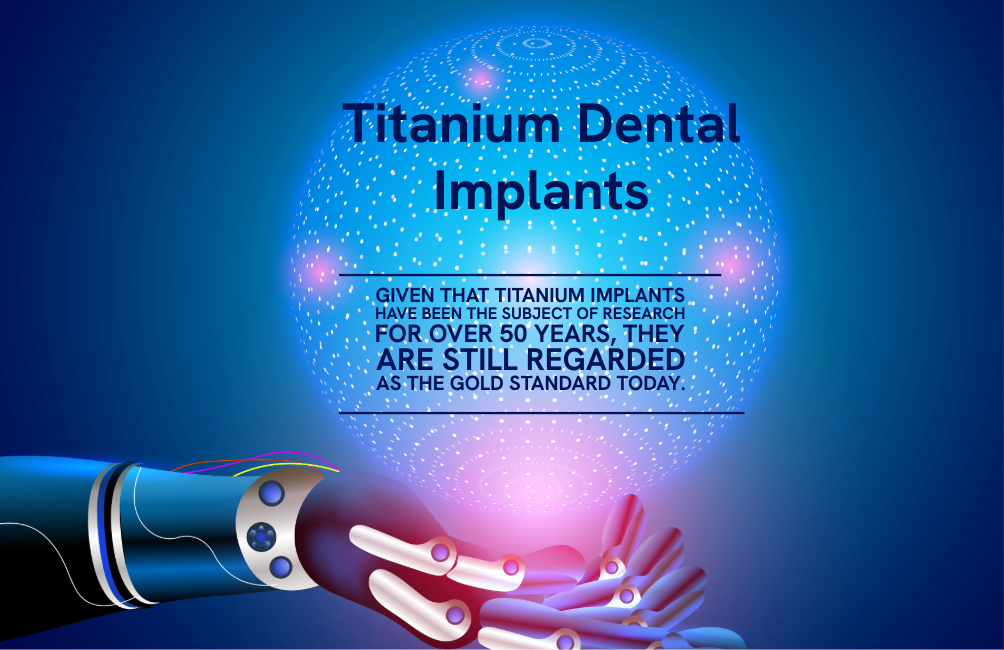
Dental implants made of titanium have been around since the 1960s. Since then, thousands of studies have been carried out on titanium implants, and their effectiveness and longevity have been proven in hundreds of thousands of patients. In fact, there are more than 100 scientific publications documenting the successful use of titanium implants even in different animal models.
Titanium implants are long-lasting in large part because of their surface design. Generally, the surface of the implants in the bone is rough, while the neck part at the gum level is polished and shiny. This design aims for the bone to adhere comfortably to the rough surface and the gum to adhere to the smooth surface. This ensures a strong bone-implant integration and minimises plaque build-up around the gums.
In terms of long-term performance, the vast majority of titanium implants have remained in the mouth in 15-20 year follow-up studies. With newer designs, these rates are thought to be even higher.
How Long Do Dental Crowns Last?
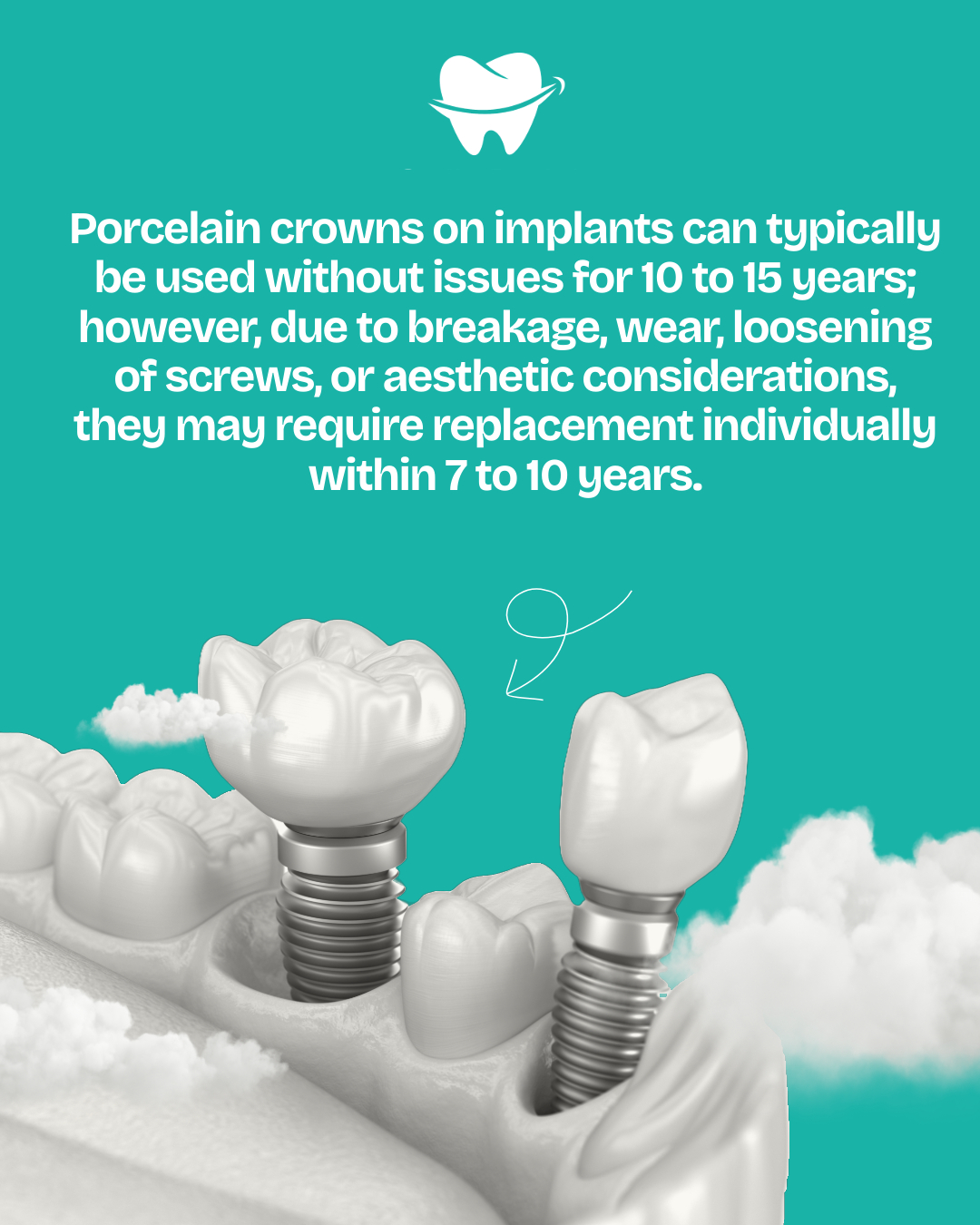
As a general rule, a porcelain dental crown is expected to last 10-15 years. In fact, there are patients who use the same crown for 20 years or more.
Conditions affecting the lifespan of implant crowns may include
- Fractures or cracks: One of the most common problems is fractures or cracks in the porcelain of the crown. Also, if the patient has a habit of clenching their teeth, tiny cracks can develop on the edges of the crown over time, eventually causing it to chip.
- Wear and teeth grinding: Over the years, some patients may notice that the surface of their crowns has flattened or lost its lustre. This is a normal wear Ceramic materials in particular can wear down somewhat over the years by friction with opposing teeth. If the patient grinds (bruxism), this wear can be more rapid.
- Changes in colour or harmony: Porcelain crowns do not change colour over time because colouring agents such as tea and coffee do not penetrate the porcelain. However, if gum recession has occurred at the edge of the crown, an aesthetic problem may occur: A metal reflection (if the base of the crown is metal) or a small cavity may appear at the gingival margin. In this case, the patient may be uncomfortable in the smile line.
- Screw loosening or substructure problems: Implant crowns are either fixed with screws (screw system) or cemented with cementation. With screw systems, the tiny screw inside the crown can loosen over the years. In this case, the crown becomes loose. The solution is easy: the dentist retightens the screw through a small hole and perhaps places a protective filling over the screw.
If the screw is under Teflon tape and composite filling, these can be cleaned, retightened and sealed. However, if the screw is constantly loosening, the screw or abutment may need to be replaced. Cemented crowns do not loosen, but the cement can melt and leak over the years, which can lead to bacterial infiltration under the crown. In such a case, it may be necessary to remove the crown and re-glue or replace it.
There is no definite guide on the frequency of replacement of implant crowns. Some dentists see patients with the same crowns for 15-20 years, while others may replace them every 7-8 years. This is completely individual. However, we can say that implant crowns may need to be replaced earlier than the implant itself.
Conclusion
People with implants should take extra care. This is because implants do not give warning signals such as pain. This silence can sometimes be dangerous because problems can develop around the implant even if the patient does not realise it. However, if the patient goes for regular check-ups, the dentist can detect and prevent these problems early. Otherwise, by the time they are recognised, it may be too late.
For the most part, dental implants can last a lifetime if taken care of properly. This can only take place if all three of the following are met: proper pre-operative planning and surgery; appropriate post-operative care and follow-up; and appropriate prosthetic design and materials. When all three of these conditions are satisfied, your implants will adapt to your changing needs and provide years of comfortable wear.
Frequently Asked Questions
Do dental implants really last a lifetime?
Under the right conditions, yes, dental implants can last a lifetime. The material of the implants (titanium) is compatible with the body and does not rust or rot. If the implant fuses with the bone in a healthy way after placement and the gum and bone support around it is maintained, it can theoretically remain in the mouth for life.
Which factors shorten the life of implants?
The main factors that can shorten the life of an implant include insufficient bone support, thin or unhealthy gums, poor oral hygiene, clenching (bruxism), smoking and systemic diseases. In addition, uncontrolled diabetes or heavy smoking increases the risk of implant failure. Eliminating these factors where possible (e.g. quitting smoking, controlling diabetes, regular brushing) prolongs the life of the implant.
How long will the prosthesis (crown) on the implant last and should it be replaced? Porcelain crowns or bridges on the implant are usually made to last 10-15 years or longer. However, this may vary depending on your chewing habits and care.
How do I know if the implant has failed or if there are problems?
Since implants do not cause pain or hot and cold sensitivity, problems can often be insidious. However, there are some warning signs that you should watch out for: These warning signs include persistent redness, swelling or bleeding in the gum around the implant, a slight movement of the tooth on the implant or a different sensation (a feeling of play) when stepping on it, bad taste or odour coming from the implant area. If you notice any of these symptoms, see your dentist immediately.
Sources:
1- Longevity of teeth and implants – a systematic review C. TOMASI, J. L. WENNSTRÖM, T. BERGLUNDH First published: 20 December 2007 https://doi.org/10.1111/j.1365-2842.2007.01831.x
2- What are the longevities of teeth and oral implants? Correction(s) for this article Poul Holm-Pedersen, Niklaus P. Lang, Frauke Müller First published: 18 June 2007 https://doi.org/10.1111/j.1600-0501.2007.01434.x
3- The Long-Term Efficacy of Currently Used Dental Implants: A Review and Proposed Criteria of Success T. Albrektsson , M.D., Ph.D./G. Zarb, D.D.S., M.S., F.R.C.D./P. Worthington , M.D., B.D.S./A.R. Eriksson, D.D.S., Ph.D.
